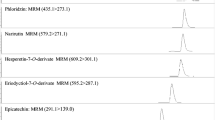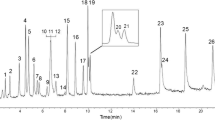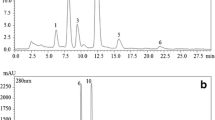Abstract
Three phenolic acids (gallic, 3,4-dihydroxybenzoic, and ellagic acids) and four hydrolyzable tannins (punicalin, punicalagins A and B, and corilagin) have been determined in pomegranate beverages and different parts of the fresh fruit and tree by liquid chromatography with diode array detection coupled to electrospray ionization and time-of-flight mass spectrometry (LC-DAD-ESI-ToFMS). For the fruit and tree analysis, the lyophilized sample was submitted to extraction in methanol for 2 h. Centrifuged and filtered beverages were diluted 1:10 with water for the quantification of corilagin and 3,4-dihydroxybenzoic acid and 1:100 for the rest of polyphenols. Calibration against external aqueous standards was used for quantification by liquid chromatography with diode array detection (LC-DAD), achieving detection limits in the 1.8–9.2 ng ml−1 range (0.2–1.1 μg g−1), depending on the compound. Matrix-matched calibration was applied for liquid chromatography coupled with electrospray ionization time-of-flight mass spectrometry (LC-ESI-ToFMS), with detection limits ranging between 0.16 and 1.4 ng ml−1 (0.02–0.17 μg g−1). Satisfactory recovery values between 88 and 110 % were obtained for beverages and solid samples spiked in the 5–100 μg ml−1 and 10–100 μg g−1 concentration ranges, respectively, with the two detection modes used. The polyphenols were quantified in the beverages between 0.3 and 325 mg l−1, for corilagin and punicalagin A, respectively, and between 0.04 and 22.82 mg g−1 (as dry matter) for 3,4-dihydroxybenzoic acid and punicalagin A, respectively, in the different parts of the fruit and tree.




Similar content being viewed by others
References
Amakura Y, Okada M, Tsuji S, Tonogai Y (2000) High-performance liquid chromatographic determination with photodiode array detection of ellagic acid in fresh and processed fruits. J Chromatogr A 896:87–93
Bakkalbaşi E, Menteş Ö, Artik N (2009) Food ellagitannins—occurrence, effects of processing and storage. Crit Rev Food Sci Nutr 49:283–298
Borges G, Crozier A (2012) HPLC-PDA-MS fingerprinting to assess the authenticity of pomegranate beverages. Food Chem 135:1863–1867
Borges G, Mullen W, Crozier A (2010) Comparison of the polyphenolic composition and antioxidant activity of European commercial fruit juices. Food Funct 1:73–83
Calani L, Beghè D, Mena P, Del Rio D et al (2013) Ultra-HPLC MSn (poly)phenolic profiling and chemometric analysis of juices from ancient Punica granatum L. cultivars: a nontargeted approach. J Agric Food Chem 61:5600–5609
Cam M, Hişil Y (2010) Pressurised water extraction of polyphenols from pomegranate peels. Food Chem 123:878–885
Chu TY, Chang CH, Liao YC, Chen Y (2001) Microwave-accelerated derivatization processes for the determination of phenolic acids by gas chromatography-mass spectrometry. Talanta 54:1163–1171
Colombo R, de Batista ANL, Teles HL, Silva GH et al (2009) Validated HPLC method for the standardization of Phyllanthus niruri (herb and commercial extracts) using corilagin as a phytochemical marker. Biomed Chromatogr 23:573–580
da Silveira CV, Trevisan MTS, Rios JB, Erben G et al (2010) Secondary plant substances in various extracts of the leaves, fruits, stem and bark of Caraipa densifolia Mart. Food Chem Toxicol 48:1597–1606
Dias FS, Silva MF, David JM (2013) Determination of quercetin, gallic acid, resveratrol, catechin and malvidin in Brazilian wines elaborated in the Vale do So Francisco using liquid-liquid extraction assisted by ultrasound and GC-MS. Food Anal Methods 6:963–968
Directive 2012/12/EU of the European Parliament and of the Council amending Council Directive 2001/112/EC relating to fruit juices and certain similar products intended for human consumption (2012) Off J Eur Un L115/1
Elfalleh W, Tlili N, Yahia Y, Hannachi H et al (2011) Antioxidant capacities of phenolic compounds and tocopherols from Tunisian pomegranate (Punica granatum) fruits. J Food Sci 76:C707–C713
Fischer UA, Carle R, Kammerer DR (2011a) Identification and quantification of phenolic compounds from pomegranate (Punica granatum L.) peel, mesocarp, aril and differently produced juices by HPLC-DAD-ESI/MSn. Food Chem 127:807–821
Fischer UA, Dettmann JS, Carle R, Kammerer DR (2011b) Impact of processing and storage on the phenolic profiles and contents of pomegranate (Punica granatum L.) juices. Eur Food Res Technol 233:797–816
Fischer UA, Jaksch AV, Carle R, Kammerer DR (2013) Influence of origin source, different fruit tissue and juice extraction methods on anthocyanin, phenolic acid, hydrolysable tannin and isolariciresinol contents of pomegranate (Punica granatum L.) fruits and juices. Eur Food Res Technol 237:209–221
Gil MI, Tomás-Barberán FA, Hess-Pierce B, Holcroft DM, Kader AA (2000) Antioxidant activity of pomegranate juice and its relationship with phenolic composition and processing. J Agric Food Chem 48:4581–4589
Gómez-Caravaca AM, Verardo V, Toselli M, Segura-Carretero A et al (2013) Determination of the major phenolic compounds in pomegranate juices by HPLC-DAD-ESI-MS. J Agric Food Chem 61:5328–5337
Gundogdu M, Yilmaz H (2012) Organic acid, phenolic profile and antioxidant capacities of pomegranate (Punica granatum L.) cultivars and selected genotypes. Sci Hortic 143:38–42
Kakasy A, Zs F, Kursinszki L, Molnár-Perl I, Lemberkovics É (2006) Analysis of non-volatile constituents in Dracocephalum species by HPLC and GC-MS. Chromatographia 63:S17–S22
Kulkarni AP, Mallikarjuna Aradhya S, Divakar S (2004) Isolation and identification of a radical scavenging antioxidant - punicalagin from pith and carpellary membrane of pomegranate fruit. Food Chem 87:551–557
Kumaran A, Karunakaran RJ (2006) Nitric oxide radical scavenging active components from Phyllanthus emblica L. Plant Foods Hum Nutr 61:1–5
Landete JM (2011) Ellagitannins, ellagic acid and their derived metabolites: a review about source, metabolism, functions and health. Food Res Int 44:1150–1160
Lu J, Wei Y, Yuan Q (2007) Preparative separation of punicalagin from pomegranate husk by high-speed countercurrent chromatography. J Chromatogr B 857:175–179
Lu J, Ding K, Yan Q (2008) Determination of punicalagin isomers in pomegranate husk. Chromatographia 68:303–306
Mallouchos A, Lagos G, Komaitis M (2007) A rapid microwave-assisted derivatization process for the determination of phenolic acids in brewer’s spent grains. Food Chem 102:606–611
Martin KR, Krueger CG, Rodriquez G, Dreher M, Reed JD (2009) Development of a novel pomegranate standard and new method for the quantitative measurement of pomegranate polyphenols. J Sci Food Agric 89:157–162
Mena P, Calani L, Dall’Asta C, Galaverna G et al (2012) Rapid and comprehensive evaluation of (poly)phenolic compounds in pomegranate (Punica granatum L.) juice by UHPLC-MSn. Molecules 17:14821–14840
Mena P, Ascacio-Valdés JA, Gironés-Vilaplana A, Del Rio D et al (2014) Assessment of pomegranate wine lees as a valuable source for the recovery of (poly)phenolic compounds. Food Chem 145:327–334
Mertens-Talcott SU, Jilma-Stohlawetz P, Ríos J, Hingorani L, Derendorf H (2001) Absorption, metabolism, and antioxidant effects of pomegranate (Punica granatum L.) polyphenols after ingestion of a standarized extract in healthy human volunteers. J Agric Food Chem 54:8956–8961
Mezcua M, Malato O, García-Reyes JF, Molina-Díaz A, Fernández-Alba AR (2009) Accurate-mass databases for comprehensive screening of pesticide residues in food by fast liquid chromatography time-of-flight mass spectrometry. Anal Chem 81:913–929
Miguel MG, Neves MA, Antunes MD (2010) Pomegranate (Punica granatum L.): a medicinal plant with myriad biological properties—a short review. J Med Plant Res 4:2836–2847
Mousavinejad G, Emam-Djomeh Z, Rezaei K, Khodaparast MHH (2009) Identification and quantification of phenolic compounds and their effects on antioxidant activity in pomegranate juices of eight Iranian cultivars. Food Chem 115:1274–1278
Ng LK, Lafontaine P, Harnois J (2000) Gas chromatographic-mass spectrometric analysis of acids and phenols in distilled alcohol beverages—application of anion-exchange disk extraction combined with in-vial elution and silylation. J Chromatogr A 873:29–38
Qu WJ, Breksa AP, Pan ZL, Ma HL (2012) Quantitative determination of major polyphenol constituents in pomegranate products. Food Chem 132:1585–1591
Saraji M, Mousavi F (2010) Use of hollow fibre-based liquid-liquid-liquid microextraction and high-performance liquid chromatography-diode array detection for the determination of phenolic acids in fruit juices. Food Chem 123:1310–1317
Seeram N, Lee R, Hardy M, Heber D (2005) Rapid large scale purification of ellagitannins from pomegranate husk, a by-product of the commercial juice industry. Sep Purif Technol 41:49–55
Sentandreu E, Cerdán-Calero M, Sendra JM (2013) Phenolic profile characterization of pomegranate (Punica granatum) juice by high-performance liquid chromatography with diode array detection coupled to an electrospray ion trap mass analyzer. J Food Compos Anal 30:32–40
Viuda-Martos M, Fernández-López JA, Pérez-Álvarez J (2010) Pomegranate and its many functional components as related to human health: a review. Compr Rev Food Sci Food Saf 9:635–654
Wang Y, Zhang H, Liang H, Yuan Q (2013) Purification, antioxidant activity and protein-precipitating capacity of punicalin from pomegranate husk. Food Chem 138:437–443
Wu QY, Zhou Y, Jin X, Guan Y, Xu M, Liu L (2011) Chromatographic fingerprint and the simultaneous determination of five bioactive components of Geranium carolinianum L. water extract by high performance liquid chromatography. Int J Mol Sci 12:8740–8749
Zhou B, Wu Z, Li X, Zhang J, Hu X (2008) Analysis of ellagic acid in pomegranate rinds by capillary electrophoresis and high-performance liquid chromatography. Phytochem Anal 19:86–89
Acknowledgments
We acknowledge the Comunidad Autónoma de la Región de Murcia (CARM, Fundación Séneca, Project 15217/PI/10) for financial support. G. Férez-Melgarejo acknowledges a fellowship financed by CARM.
Conflict of Interest
G. Férez-Melgarejo has received grants from CARM, Murcia, Spain. This article does not contain any study with human or animal subjects.
Author information
Authors and Affiliations
Corresponding author
Rights and permissions
About this article
Cite this article
Campillo, N., Viñas, P., Férez-Melgarejo, G. et al. Determination of Phenolic Acids and Hydrolyzable Tannins in Pomegranate Fruit and Beverages by Liquid Chromatography with Diode Array Detection and Time-of-Flight Mass Spectrometry. Food Anal. Methods 8, 1315–1325 (2015). https://doi.org/10.1007/s12161-014-0013-6
Received:
Accepted:
Published:
Issue Date:
DOI: https://doi.org/10.1007/s12161-014-0013-6




